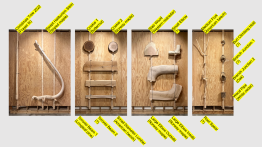Zachary Mollica: Other Wood Pieces
Tue, Oct 1, 12pm - Sun, Oct 27, 2024 6pm

An earlier mounting of the Other Wood Pieces collection annotated with informal piece names and tree species.
In conjunction with this exhibition, Zachary Mollica will be speaking at The Cooper Union with paleoclimate scientist Valerie Trouet on October 15th (details are available here).
----------------
When we build with wood using just a few species sawn into a few formats, we directly contribute to the simplification of forest ecosystems around the world. If we could re-diversify the ways we build with wood, we could actively encourage the re-establishment of healthier systems.
This exhibition presents twenty-three pieces of uncommon wood, including bends, a fork, cookies, burrs, salvaged beams, and a piece of root. At least ten tree species are represented, such as beech, butternut, fir, maple, and oak. Among these are pieces I have acquired by many means: found in a grocery store parking lot, cut from the forest, passed on by my grandfather, and more. Each piece has been obsessively prepared: dried, sawn, planed, peeled, carved, and sanded. Each is presented in the hallway as raw material to be considered for use in future designs.
Together with several large format drawings and short texts, Other Wood Pieces is part of an ongoing project to reflect on and share lessons gained over twenty years of work as a designer concerned primarily with materials found within trees. Supported by many, my own approach has slowly grown.
My engagement with trees is rooted in wonder: here are the oldest living beings whose bodies are self-optimizing, self-repairing structures that embed the environmental systems they require for life. Trees and their relatives terrestrialized the earth, their rings record our planet’s history, and their products have been critical to each moment of human technological development.
Other Wood Pieces is presented in three parts:
- An unusual collection of wood pieces that vary by species, format, and source.
- Several large format drawings that illustrate how many other products might be taken from
trees as well as how their evolutionary history might inform our understanding of wood
properties.
- A series of short texts that present observations gained along the way.
Together, these form a manifesto that drives my work in the Using Trees Studio.
Zachary Mollica
An educator, architect, and maker who works with trees, Zachary Mollica integrates digital methods with craft and material knowledge in pursuit of better ways to build. Zac recently completed a two-year term as the inaugural Emerging Architect Fellow at the University of Toronto’s Daniels Faculty of Architecture, Landscape and Design where he is now a part-time assistant professor.
Until 2021, Zac lived in and led Hooke Park, a 350-acre working forest in Dorset, England, that is a second home for students of the Architectural Association. Surrounded by trees, tools and multiskilled collaborators, in Hooke Park, Zac contributed to novel projects deploying alternative forest products. These built on earlier contributions by Andy Goldsworthy, Frei Otto, Martin Self, and many others.
Zac carries on this work in Canada through the Using Trees Studio. With various groups, he is engaged in teaching, research, and project work. His work can also be viewed at @zacharymollica and @usingtrees.
Held in the Foundation Building's Third Floor Hallway Gallery.
Open to the general public:
Tuesday–Friday, 12pm – 7pm
Saturday & Sunday, 12pm – 6pm
This exhibition is made possible by the New York State Council on the Arts with the support of the Office of the Governor and the New York State Legislature.

Located at 7 East 7th Street, between Third and Fourth Avenues




